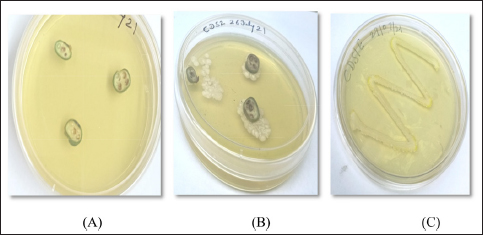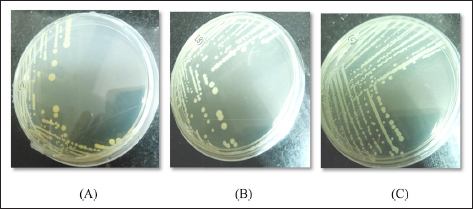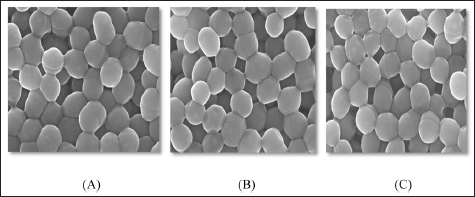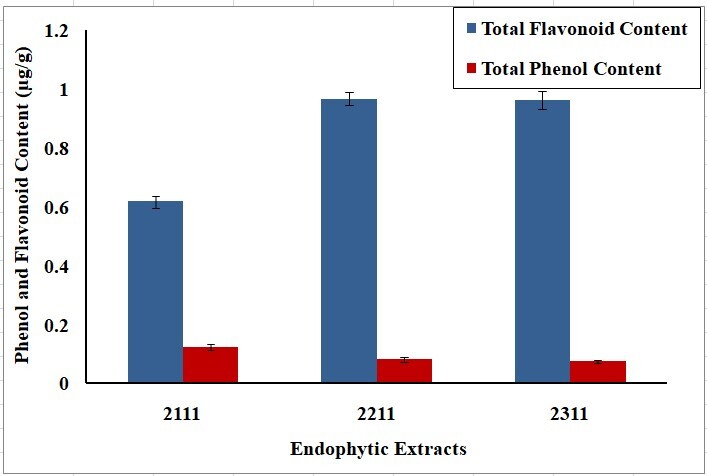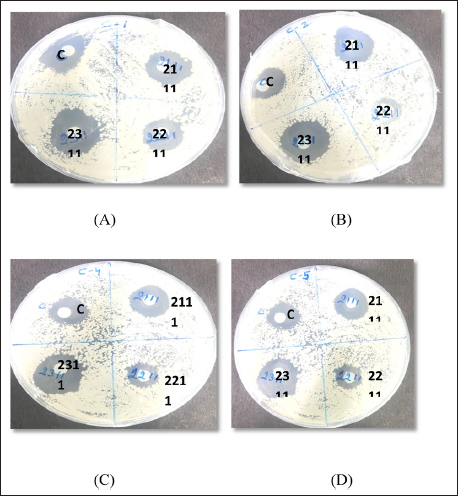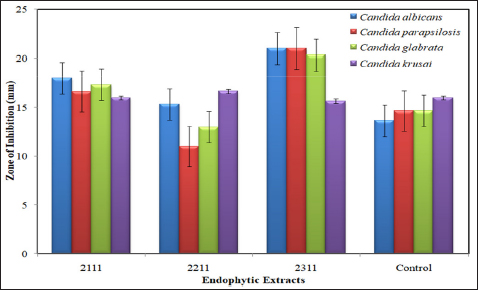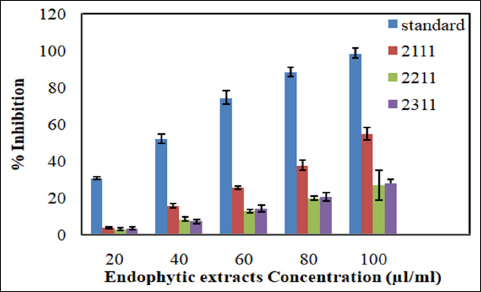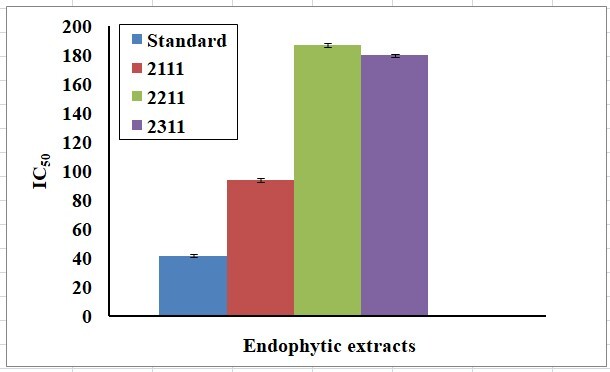1. INTRODUCTION
Due to global warming, more and more fungal pathogens can survive and multiply at human body temperature [1]. This is the reason that outbreaks of fungal infections are likely to occur in the coming years if not controlled [2]. Resistance to currently available antifungal drugs is increasing at an alarming rate, worsening the situation [3]. Therefore, the development of new antifungal drugs with broad-spectrum activity, low toxicity, and resistance is an important goal for both academia and the pharmaceutical industry [4]. The most common fungal infections in humans are caused by Candida sp. [5]. In the past two decades, the incidence of Candida infections has increased due to the irregular use of broad-spectrum antibiotics and the limited number of antifungal drugs to control fungal infections [6]. Therefore, there is an urgent need for new compounds with antifungal activity. One possible approach could be to screen endophytic bacterial isolates for the presence of competent antifungal chemotherapeutic metabolites.Endophytic microorganisms live symbiotically in various plant tissues. They contribute either directly or indirectly to increasing plant tolerance to abiotic (pressure, temperature) and biotic (microbial) stresses. To cope with environmental stresses, plants synthesize various bioactive metabolites, both individually and in enhanced production by endophytic strains [7,8]. However, this requires isolating endophytes and studying their metabolites, which not only saves time but also does not affect plant diversity.
Ethnomedicinal uses of Capparis decidua: Capparis decidua (Forssk) Edgew belongs to the class Magnoliopsida in the family Capparaceae. This small, branched shrub is native to the arid regions of the Asian continent. It has ethnobotanical importance in folk medicine and is also used to treat various ailments such as rheumatism, respiratory problems, diabetes, microbial infections, hypertension, free radical scavenger, and various stomach problems [9]. Since C. decidua exhibits activity against microbes [10], there is a possibility that its endophytes could be involved either directly or indirectly in various pharmaceutical activities.
REFERENCES
1. Nnadi, NE. Carter DA. Climate change and the emergence of fungal pathogens. PLoS Pathogens. 2021;17:e1009503. [CrossRef].
2. Ngo HX, Garneau-Tsodikova S, Green KD. A complex game of hide and seek: the search for new a ntifungals. Medchemcomm. 2016;7(7):1285-306. [CrossRef].
3. Fisher MC, Alastruey-Izquierdo A, Berman J, Bicanic T, Bignell EM, Bowyer P, et al. Tackling the emerging threat of antifungal resistance to human health. Nat Rev Microbiol. 2022:20(9):557-71. [CrossRef]
4. Mani Chandrika KVS, Sharma S. Promising antifungal agents: a minireview. Bioorganic Med Chem. 2020;28(7):115398. [CrossRef]
5. Das G, Park S, Choi J, Baek KH. Anticandidal potential of endophytic bacteria isolated from dryopteris uniformis (Makino). Jundishapur J Microbiol. 2019;12(1):e69878. [CrossRef]
6. Mehmood Z, Ahmad I, Mohammad F, Ahmad S. Indian medicinal plants: a potential source for anticandidal drugs. Pharm Biol. 1999;37(3):237-42. [CrossRef]
7. Tyagi J, Chaudhary P, Mishra A, Khatwani M, Dey S, Varma A. Role of endophytes in abiotic stress tolerance: with special emphasis on serendipita indica. Int J Environ Res. 2022;16(4):62. [CrossRef]
8. Chaudhary P, Agri U, Chaudhary A, Kumar A, Kumar G. Endophytes and their potential in biotic stress management and crop production. Front Microbiol. 2022;13(October):933017. [CrossRef]
9. Singh P, Mishra G, Sangeeta, Srivastava S, Jha KK, Khosa RL. Traditional uses, phytochemistry and pharmacological properties of capparis decidua: an overview. Der Pharm Lett. 2011;3(2):71-82.
10. Upadhyay RK, Ahmad S, Tripathi R, Rohtagi L, Jain SC. Screening of antimicrobial potential of extracts and pure compounds isolated from capparis decidua. J Med Plants Res. 2010;4(6):439-45.
11. Duhan P, Bansal P, Rani S. Isolation, identification and characterization of endophytic bacteria from medicinal plant tinospora cordifolia. South African J Bot. 2020;134:43-9. [CrossRef]
12. Photolo MM, Mavumengwana V, Sitole L, Tlou MG. Antimicrobial and antioxidant properties of a bacterial endophyte, methylobacterium radiotolerans MAMP 4754, isolated from combretum erythrophyllum seeds. Int J Microbiol. 2020;2020:9483670. [CrossRef]
13. Rahman L, Shinwari ZK, Iqrar I, Rahman L, Tanveer F. An assessment on the role of endophytic microbes in the therapeutic potential of fagonia indica. Ann Clin Microbiol Antimicrob. 2017;16(1):53. [CrossRef]
14. Bertini L, Perazzolli M, Proietti S, Capaldi G, Savatin DV, Bigini V, et al. Biodiversity and bioprospecting of fungal endophytes from the Antarctic plant colobanthus quitensis. J Fungi. 2022;8(9):979. [CrossRef]
15. Aiyegoro OA, Okoh AI. Research article preliminary phytochemical screening and in vitro antioxidant activities of the aqueous extract of helichrysum longifolium DC. BMC Complement Altern Med. 2010;10(1):21. [CrossRef]
16. Eloff JN. A sensitive and quick microplate method to determine the minimal inhibitory concentration of plant extracts for bacteria. Planta Med. 1998;64(8):711-3. [CrossRef]
17. Chhillar AK, Yadav V, Kumar A, Kumar M, Parmar VS, Prasad A, Sharma GL. Differential expression of aspergillus fumigatus protein in response to treatment with a novel antifungal compound, diethyl 4-(4-methoxyphenyl)-2,6-dimethyl-1,4-dihydropyridin-3,5-dicarboxylate. Mycoses. 2009;52(3):223-7. [CrossRef]
18. Takao LK, Imatomi M, Gualtieri SCJ. Antioxidant activity and phenolic content of leaf infusions of myrtaceae species from cerrado (Brazilian Savanna). Brazilian J Biol. 2015;75(4):948-52. [CrossRef]
19. Pawle G, Singh SK. Antioxidant potential of endophytic fungus colletotrichum species isolated from polygala elongata. Int J Pharma Bio Sci. 2014;5:B313-9.
20. Ek-Ramos MJ, Gomez-Flores R, Orozco-Flores AA, Rodríguez-Padilla C, González-Ochoa G, Tamez-Guerra P. Bioactive products from plant-endophytic gram-positive bacteria. Front Microbiol. 2019;10(March):463. [CrossRef]
21. Pandey SS, Singh S, Pandey H, Srivastava M, Ray T, Soni S, et al. Endophytes of withania somnifera modulate in planta content and the site of withanolide biosynthesis. Sci Rep. 2018;8(1):5450. [CrossRef]
22. Matuszewska A, Jaszek M, Stefaniuk D, Ciszewski T, Matuszewski ?. Anticancer, antioxidant, and antibacterial activities of low molecular weight bioactive subfractions isolated from cultures of wood degrading fungus cerrena unicolor. PLoS One. 2018:13(6):e0197044. [CrossRef]
23. Peng C, Zhuang X, Gao C, Wang Z, Zhao J, Huang SX, et al. Streptomyces typhae Sp. Nov., a novel endophytic actinomycete with antifungal activity isolated the root of cattail (typha angustifolia L.). Antonie van Leeuwenhoek. Int J Gen Mol Microbiol. 2021;114(6):823-33. [CrossRef]
24. Devi R, Nath T, Boruah RR, Darphang B, Nath PK, Das P, et al. Antimicrobial activity of bacterial endophytes from chirata (swertia chirata wall.) and datura (datura stramonium L.). Egypt J Biol Pest Control. 2021;31(1):69. [CrossRef]
25. Khan W, Subhan S, Shams DF, Afridi SG, Khan AJ, Iqbal A. In vitro assessment of the antibacterial activity of datura alba with different solvents. Fresenius Environ Bull. 2019;28(10):7333-9.
26. Hamayun M, Khan N, Khan MN, Qadir M, Hussain A, Iqbal A, et al. Antimicrobial and plant growth-promoting activities of bacterial endophytes isolated from calotropis procera (Ait.) W.T. Aiton. Biocell. 2021;45(2):363-9. [CrossRef]
27. Putri DH, Violita V, Irdawati, Fifendy M, Nurhasnah N. Production of antifungal compounds by andalas endophytic bacteria (Morus Macroura Miq.) isolate ATB 10-6 at fermentation medium with optimum carbon and organic nitrogen source. J Phys Conf Ser. 2021;1940(1):012076. [CrossRef]
28. Strobel G, Daisy B. Bioprospecting for microbial endophytes and their natural products. Microbiol Mol Biol Rev. 2003;67(4):491-502. [CrossRef]
29. Davis-Hanna A, Piispanen AE, Stateva LI, Hogan DA. Farnesol and dodecanol effects on the candida albicans Ras1-CAMP signalling pathway and the regulation of morphogenesis. Mol Microbiol. 2008;67(1):47-62. [CrossRef]
30. Rioba NB, Stevenson PC. Ageratum conyzoides L. for the management of pests and diseases by small holder farmers. Ind Crops Prod. 2017;110(July):22-9. [CrossRef]
31. Gushiken LFS, Beserra FP, Hussni MF, Gonzaga MT, Ribeiro VP, De Souza PF, et al. Beta-caryophyllene as an antioxidant, anti-inflammatory and re-epithelialization activities in a rat skin wound excision model. Oxid Med Cell Longev. 2022;2022:9004014. [CrossRef]
32. Hilgers F, Habash SS, Loeschcke A, Yannic Sebastian Ackermann, Neumann S, Heck A, et al. 2021 heterologous production of β-caryophyllene microorganisms-09-00168 (1).Pdf. Microorganisms. 2021;9:168.
33. Garnier L, Penland M, Thierry A, Maillard MB, Jardin J, Coton M, et al. Antifungal activity of fermented dairy ingredients: identification of antifungal compounds. Int J Food Microbiol. 2020;322(November 2019):108574. [CrossRef]
34. Aneja M, Gianfagna TJ, Hebbar PK. Trichoderma harzianum produces nonanoic acid, an inhibitor of spore germination and mycelial growth of two cacao pathogens. Physiol Mol Plant Pathol. 2006;67(6):304-7. [CrossRef]
35. Sholkamy EN, Muthukrishnan P, Abdel-Raouf N, Nandhini X, Ibraheem IBM, Mostafa AA. Antimicrobial and antinematicidal metabolites from streptomyces cuspidosporus strain SA4 against selected pathogenic bacteria, fungi and nematode. Saudi J Biol Sci. 2020;27(12):3208-20. [CrossRef]
36. Dos Reis CM, da Rosa BV, da Rosa GP, do Carmo G, Morandini LMB, Ugalde GA, et al. Antifungal and antibacterial activity of extracts produced from diaporthe schini. J Biotechnol. 2019;294:30-7. [CrossRef]
37. Roy RN. Bioactive natural derivatives of phthalate ester. Crit Rev Biotechnol. 2020;40(7):913-29. [CrossRef]
38. Kiran GS, Priyadharsini S, Sajayan A, Ravindran A, Selvin J. An antibiotic agent pyrrolo[1,2-: A] pyrazine-1,4-dione,hexahydro isolated from a marine bacteria bacillus tequilensis MSI45 effectively controls multi-drug resistant staphylococcus aureus. RSC Adv. 2018;8(32):17837-46. [CrossRef]
39. Ser HL, Palanisamy UD, Yin WF, Abd Malek SN, Chan KG, Goh BH, et al. Presence of antioxidative agent, pyrrolo[1,2-a]pyrazine-1,4-dione, hexahydro- in newly isolated streptomyces mangrovisoli Sp. Nov. Front Microbiol. 2015;6(August):854. [CrossRef]
40. Zhao F, Wang P, Lucardi RD, Su Z, Li S. Natural sources and bioactivities of 2,4-di-tert-butylphenol and its analogs. Toxins (Basel). 2020;12(1):35. [CrossRef]
41. Zhu F, Yuan C, Gang F, Yang C, Wu W, Zhang J. Bioassay-guided isolation of antifungal compounds from disporopsis aspersa (hua) engl. ex diels against pseudoperonospora cubensis and phytophthora infestans. Chem Biodivers. 2018;15(7):e1800090. [CrossRef]
42. Krátký M, Kone?ná K, Janoušek J, Brablíková M, Jan?ourek O, Trejtnar F, et al. 4-aminobenzoic acid derivatives: converting folate precursor to antimicrobial and cytotoxic agents. Biomolecules. 2020;10(1):9. [CrossRef]
43. Sahin N, Kula I, Erdogan Y. Investigation of antimicrobial activities of nonanoic acid derivatives. Fresenius Environ Bull. 2006;15(2):141-3.
44. Mangamuri UK, Muvva V, Poda S, Manavathi B, Bhujangarao C, Yenamandra V. Chemical characterization & bioactivity of diketopiperazine derivatives from the mangrove derived pseudonocardia endophytica. Egypt J Aquat Res. 2016;42(2):169-75. [CrossRef]
45. Amudha P, Jayalakshmi M, Pushpabharathi N, Vanitha V. Identification of bioactive components in enhalus acoroides seagrass extract by gas chromatography–mass spectrometry. Asian J Pharm Clin Res. 2018;11(10):313-7. [CrossRef]
46. Druzian SP, Pinheiro LN, Susin NMB, Dal Prá V, Mazutti MA, Kuhn RC, Terra LdM. Production of metabolites with antioxidant activity by botryosphaeria dothidea in submerged fermentation. Bioprocess Biosyst Eng. 2020;43(1):13-20. [CrossRef]
47. Cheng MC, Ker YB, Yu TH, Lin LIY, Peng RY, Peng CH. Chemical synthesis of 9(z)-octadecenamide and its hypolipidemic effect: a bioactive agent found in the essential oil of mountain celery seeds. J Agric Food Chem. 2010;58(3):1502-8. [CrossRef]
48. Sanjenbam P, Krishnan K. Bioactivity of pyrrolo[1,2-A]pyrazine-1,4-dione,hexahydro-3-(phenylmethyl)- extracted from streptomyces Sp. VITPK9 isolated from the salt spring habitat of Manipur, India. Asian J Pharm. 2016;10(4):265-70.
49. El Ridi R, Tallima H. Physiological functions and pathogenic potential of uric acid: a review. J Adv Res. 2017;8(5):487-93. [CrossRef]
